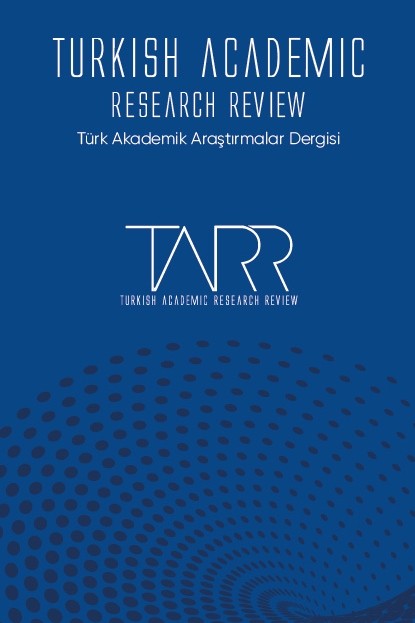“Manzūme-i Ferā’iz”de Geçen Türemiş Fiillerin Morfolojik Açıdan İncelenmesi
Manzūme-i Ferā’iz, hem Doğu Türkçesinin hem de Batı Türkçesinin dil özelliklerini bir arada muhafaza eden karışık dilli eserlerden biridir. Eser, Muhammed bin Abbas tarafından telif edilmiş olup manzum bir biçimde yazılmıştır. İçerik olarak miras konusunu ele alan eserde, yoğun bir şekilde Arapça ve Farsça sözcük bulunmaktadır. Eser mirasın nasıl dağıtılacağı, kimlere nasıl paylaştıracağı detaylı bir şekilde anlatılmıştır. Zengin kültür birikimi dolayısıyla hayatın çok farklı alanlarına pencere aralayan bu müstesna edebiyat eserinin en önemli özelliklerinden biri de İslam dininin çağlar üstü mesajlarından etkilenmesi ve bu etki dolayısıyla İslamį bir yönünün bulunmasıdır. İnsana mülkiyet hakkı tanımayan, kadına miras hakkı vermeyen çeşitli hukuk sistemlerinin mevcut olageldiği bir dünyada Kur’an-ı Kerim’le birlikte yaşanan aydınlanmayla adaleti sağlayan ve ayrıntılarıyla izah edilen bir miras hukukunun vücut bulması tüm medeniyetler adına bir devrim olmuştur. Miras konusunun İslam hukuku ile ilişkili olması ve ahiret hayatını doğrudan ilgilendirmesi bu eseri cazip kılmıştır. Türk dili bakımından farklı konuların işlenmesi de hâliyle dilin söz varlığını genişletmiştir. Çalışma oluşturulurken Eyüp Sertaç Ayaz’ın Manzūme-i Ferâ’iz adlı şerhi esas alınmıştır. Bir fiilin sahip olduğu anlam aldığı eklerle değişir. Bu noktada ekler eklendikleri fiillere farklı anlamlar yükler. Bu nedenle eklerin fiil türetmedeki işlevi oldukça önem taşır. Eski Anadolu Türkçesinin dil özelliklerini taşıyan eser içerisindeki türemiş fiillerin tamamına yakın olanı Türkçe kökenlidir. Çalışmada eser içerisinde bulunan türemiş fiiller, tarama yöntemiyle tespit edilmiş ve sayısal olarak değerlendirilmiştir. Söz konusu türemiş fiillerin metin içerisindeki kullanım sıklığı ortaya konmuş ve bu fiiller metin numaraları ile verilmiştir. Bunun yanı sıra fiiller yapı bakımından değerlendirilmiş olup türemiş fiillerin hangi eklerle oluştuğu analiz edilmiştir. Eklerin türetilen fiillere kattıkları anlamlar ise bu verilere bağlı olarak değerlendirilmiştir. Elde edilen fiiller hakkındaki incelemeler sonucunda belli çıkarımlara ulaşılmıştır.
Anahtar Kelimeler:
Manzūme-i FerāǾiz, Muhammed bin Abbas, Karışık Dilli Eserler, Fiiller, Türemiş Fiiller.
Morphological Analysis of Derived Verbs in "Manzūme-i Ferâ’iz"
Manzūme-i Ferā’iz is one of the mixed-language works that preserves the linguistic features of both Eastern Turkish and Western Turkish. The work was copyrighted by Mohammed bin Abbas and was written in verse. In the work, which deals with the subject of heritage as its content, there are intense Arabic and Persian words. It has been explained in detail how the work will be distributed and how it will be distributed to whom. One of the most important features of this exceptional literary work, which opens a window to many different areas of life due to its rich cultural accumulation, is that the religion of Islam is influenced by the messages of the ages and has an Islamic aspect due to this effect. In a world where there are various legal systems that do not give people the right to property and do not give the right of inheritance to women, the emergence of an inheritance law that provides justice and explained in detail with the enlightenment experienced with the Qur'an has been a revolution for all civilizations. The fact that the subject of inheritance is related to Islamic law and is directly related to the hereafter has made this work attractive. The treatment of different subjects in the Turkish language naturally expanded the vocabulary of the language. While creating the study, Eyüp Sertaç Ayaz's commentary named Manzūme-i Ferā’iz was taken as a basis. The meaning of a verb changes with the suffixes it takes. At this point, suffixes give different meanings to the verbs to which they are added. For this reason, the function of suffixes in verb derivation is very important. Almost all of the derived verbs in the work, which have the linguistic features of Old Anatolian Turkish, are of Turkish origin. In the study, the derived verbs in the work were determined by scanning method and evaluated numerically. The frequency of use of these derivative verbs in the text has been revealed and these verbs are given with text numbers. In addition, the verbs were evaluated in terms of structure and the suffixes of the derived verbs were analyzed. The meanings that the suffixes add to the derived verbs are evaluated depending on these data. As a result of the examinations about the verbs obtained, certain inferences were reached.
Keywords:
Manzūme-i FerāǾiz, Muhammed bin Abbas, Mixed Language Works, Verbs, Derived Verbs.,
___
- Ayaz, E. S. (2016). Manzume-i Fera'iz-Muhammed Bin Abbas: (Giriş-İnceleme-Metin-Dizin). Ankara: Kesit Yayınları.
- Datlı, D. (2015). Risâletü’n-Nushiyye’nin Birleşik Fiil Örgüsü. Turkish Studies, 10/8, 795-818. http://dx.doi.org/10.7827/TurkishStudies.8315
- Ediskun, H. (1963). Yeni Türk Dil Bilgisi. İstanbul: Remzi Kitabevi.
- Ercilasun, A. B. (2008). Türk Dili Tarihi. Ankara: Akçağ Yayınları.
- Ergin, M. (2004). Türk Dil Bilgisi. İstanbul: Bayrak Basım.
- Gencan, T. N. (2001). Dil Bilgisi. İstanbul: Ayraç Yayınevi.
- Güler, M. (2015). Türk Edebiyatında Manzum Ferâiz-Nâmeler. Doktora Tezi. Sivas: [Cumhuriyet Üniversitesi, Sosyal Bilimler Enstitüsü].
- Gülsevin, G.& Boz, E. (2013). Eski Anadolu Türkçesi. Ankara: Gazi Kitabevi.
- Yayın Aralığı: Yılda 4 Sayı
- Başlangıç: 2016
- Yayıncı: Mehmet ŞAHİN
Sayıdaki Diğer Makaleler
İmâmiyye Fıkhının Sistemleştiricisi: Muhakkık Hillî ve Usûl Görüşleri
Yeni Dini Hareketler ve Şiddet: Bir Tipoloji
Salih Emre KARAYEL, Çevirmen: Salih Emre KARAYEL
BİLSEM Öğretmenlerinin Uzaktan Eğitim Sürecine Yönelik Metaforik Algıları
Bursalı Bir Şair: Murat Aydınlılar Şiirinde Huzursuzluk
Sabri Esat Siyavuşgil’in Gözünden Ahmet Mithat
Tarihi Ankara Hamamlarının Tipolojik Analizi
Avrupamerkezci Yaklaşım ve Şark Müziği Tarihi: Henry George Farmer Örneği
Covid-19 Sonrasında Uzaktan (Çevrim içi) Yabancı Dil Öğretimi İlkeleri Üzerine Bir Araştırma
